Are you thinking about starting a publication on Substack? Substack is a very powerful platform for writers and creators, and starting a publication can be a rewarding (not to mention potentially very lucrative*) experience. But where do you begin?
Getting started with a new platform and putting your work out there can be daunting. So, to help you to get to grips with the platform and make your content stand out, we’ve created a list of 15 tips for success — covering everything from identifying your target audience to monetizing your content.
Whether you’re a seasoned writer or a complete beginner, these should help you to make your foray into Substack a success.
(*Here’s a great success story to inspire you.)
Let’s get started…
1. Find Your Niche
With so many topics to choose from, deciding what area to focus on can be a challenge. Here are a few steps you can follow to help you decide what to write about:
- Consider your expertise and interests: As the saying goes, write what you know. Which topics do you have a lot of knowledge of or experience in? What are you most passionate about? Writing about what you know and care about will help you to create content that’s authentic and engaging, and also keep you motivated, which is crucial if you want to build up your publication over the long term.
- Research what’s already out there: It’s likely you’re starting a publication because you already have a topic in mind and have something to say. However, it’s also worth considering why people may want to read your take on the subject, and think of what new angle or approach you can bring to the table — e.g. is there a gap for this kind of content that you’ve noticed, or an audience that’s being underserved that you can speak to? Look at what other publications in your niche are writing about to see what they may be missing. This can help you to identify topics that are underrepresented or areas where you can add your own unique perspective.
- Some categories/niches on Substack to consider include: Culture, Politics, Technology, Business, Finance, Food & Drink, Sports, Faith & Spirituality, News, Music, Comics, Crypto, International, Art & Illustration, Climate, Science, Health & Wellness, Literature, Fiction, Parenting, Design, Travel, Education, Philosophy, History, Humor and Fashion & Beauty.
- Get feedback from your target audience: Consider asking them what they’d like to see in your publication. You can do this through surveys, focus groups or by simply asking for feedback in your newsletters or on social media.
- See what works for others: Substack is a huge platform with many incredible (and very successful) writers. Take a look through as many examples as you can of publications that are already smashing it. Here’s a link to various stories of writers who have already made it and here’s a link to some current ‘Staff Picks’ for publications on Substack.
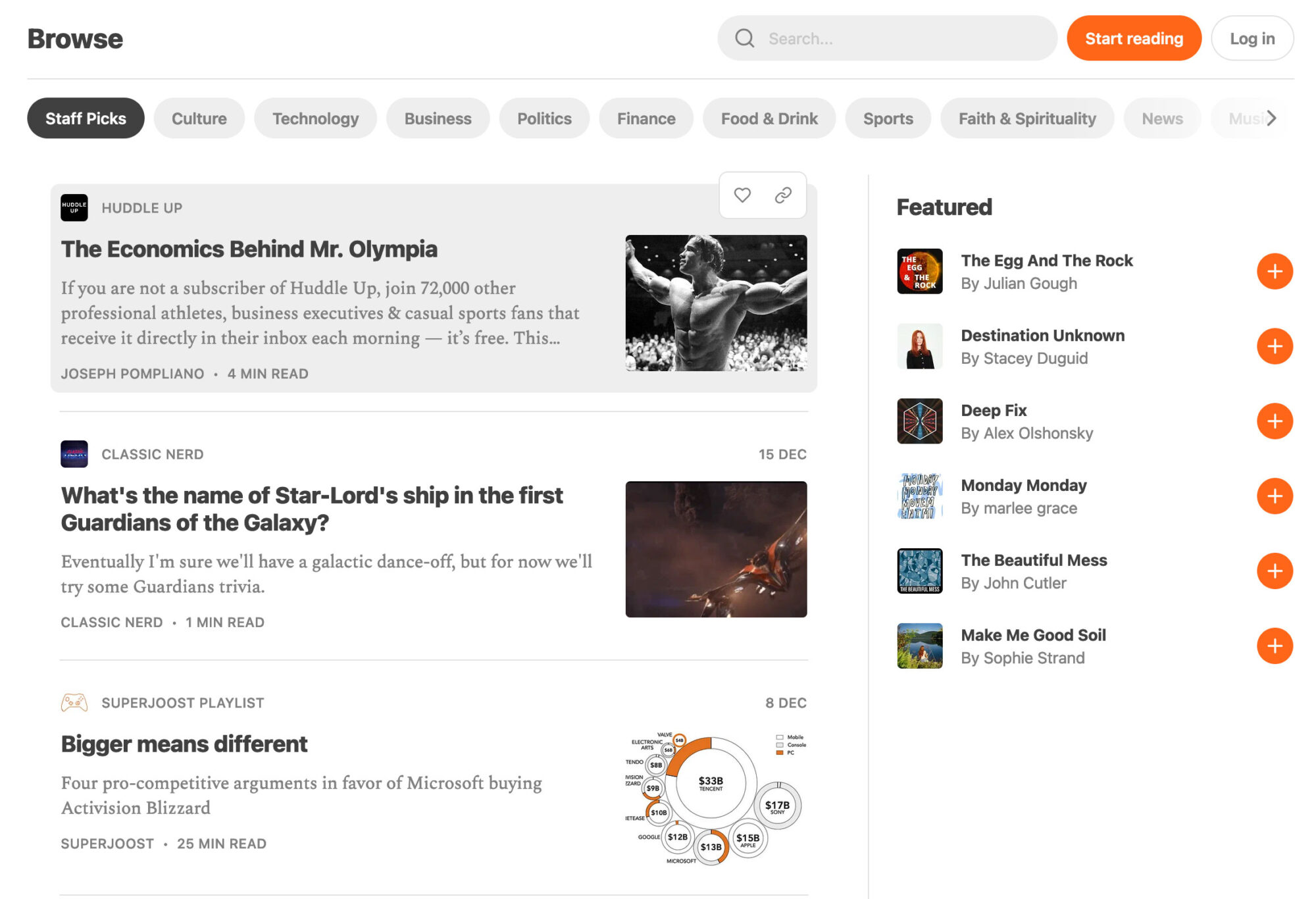
The success of any publication hinges on creating content that resonates with readers and builds a loyal following.
Why Choose a Niche? (Click to Expand)
Choosing a niche is a crucial step. It will define what your publication is about and help you to attract readers who are interested in your area of expertise.
Here are some reasons why choosing a niche is important:
- It helps you stand out: In a crowded marketplace, it can be difficult to get noticed. By choosing a niche, you can differentiate your publication and attract readers who are specifically interested in your topic.
- It allows you to become an expert: By focusing on a specific topic, you can become an expert in your field and provide valuable insights and information to your readers.
- It helps you build a loyal following: By attracting readers who are interested in your specific niche, you can build a loyal following of readers who are engaged with your content.
- It can be monetized more easily: If you choose a niche that has a clear potential for monetization, you may have more success in generating revenue for your publication.
Overall, choosing a niche will help you build a loyal following and vastly increase the chances of success for your publication.
2. Identify Your Target Audience
Publications need readers, and it’s important to have a clear understanding of who you want to reach, so you can create content that appeals to them and grow your audience.
Here are some steps you can take to identify your target audience:
- Define your ideal reader: Consider who your ideal reader is and what their interests and needs are. What are their demographic (age, gender, location, etc.)? What are their goals and challenges? Knowing who you’re talking to can help you to create content they’ll respond to.
- Research your audience: Use online tools, such as social media analytics or surveys, to learn more about your target audience and their needs, wants and preferences.
- Create ‘buyer’ personas: Buyer personas are fictional representations of your ideal audience/customers. Creating buyer personas can help you to understand your target audience on a deeper level and create content that speaks directly to their needs and interests.
- Test your assumptions: Once you have a clear understanding of your target audience, test your assumptions by creating a small sample of content and sharing it with a group of people who fit your target audience profile. This will help you to see how your audience might respond to your content.
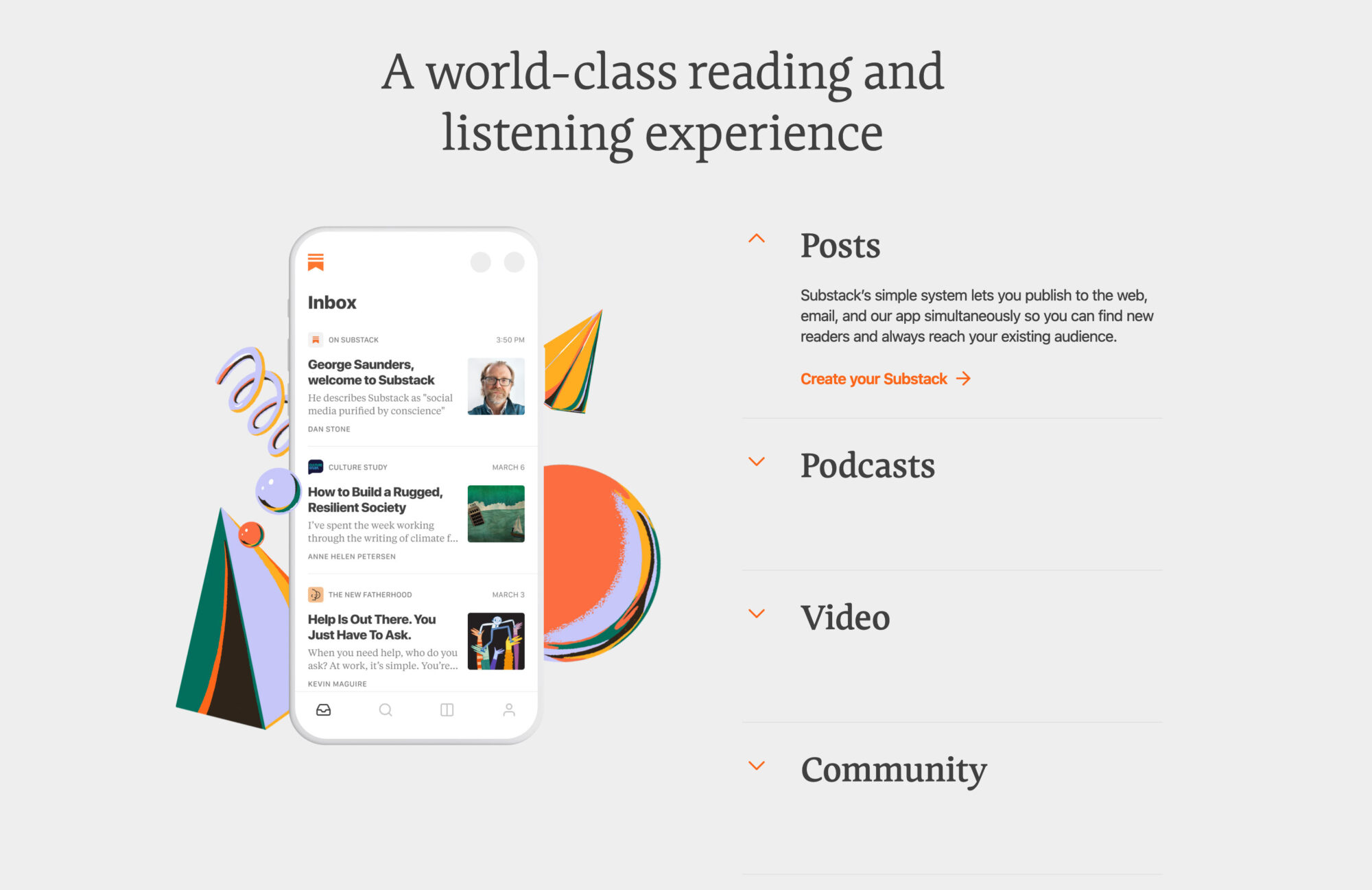
You’ll need to develop a deep understanding of your target audience and create content that speaks directly to their needs and interests.
3. Name Your Publication
On top of all of the technical details of setting up your first Substack (here’s the official resources/guide page on Substack to accomplish exactly those things), choosing a name for your publication can be a challenging task. Here are a few tips:
- Consider your target audience: Think about who you want to reach with your publication. What are their interests and needs? Try to find a name that will resonate with them and reflect the content you plan to create.
- Keep it simple: Pick something that’s easy to spell and pronounce. Avoid using difficult or obscure words or phrases that may be hard for readers to remember.
- Make it memorable: Choose a name that’s unique, and that people will remember. Avoid using generic or common terms that may be hard to differentiate from other publications.
- Search for your ideas on social media: Use the search function on social media platforms such as Twitter, Instagram and Facebook to see if any accounts are already using your name ideas.
- Check the availability of your ideas on domain registration websites: Use websites such as GoDaddy or Namecheap to see if the options you’ve shortlisted are available as domain names.
- Check for trademark conflicts: If you plan to use your publication name for any commercial purposes, it’s a good idea to check for trademark conflicts. You can do this by searching the US Patent and Trademark Office’s database to see if any similar trademarks are already registered.
Still struggling with how to name your publication? (Click to Expand)
Here’s an earlier post of ours on the Top Ten Quick Tips on How to Choose a Name (and also a Domain Name) for a New Publication/Website.
4. Create an Interesting About Page
An about page is an important part of any website, including a Substack publication, because it helps readers to understand who you are and whether your publication is for them. Here are a few tips for writing yours:
- Start with a strong introduction: Introduce yourself and your publication using a brief, engaging summary that tells readers who you are and what your publication is about.
- Tell your story: Use your about page to share your story and say why you started your publication. This can help readers to understand your motivations and create a personal connection.
- Share your mission: Explaining your mission and goals will help readers to understand what you hope to achieve with your content.
- Keep it concise: Your about page should be brief and to the point. Avoid using too much jargon or technical language, and instead focus on the most important information.
- Use images or graphics: Including relevant imagery will make your page visually appealing and break up any blocks of text. Consider using a headshot or an image that represents your publication.
- Include a call to action: Make it easy for your readers to take any next steps with a call to action, such as a request to subscribe to your publication or follow you on social media.
- Include contact information: Make it easy for readers to contact you by including your email address and social media handles on your about page.
5. Develop a Content Strategy
A content strategy is a plan for creating and distributing content that aligns with your business goals and resonates with your target audience.
Here are some steps you can take to develop a content strategy for your publication:
- Determine your goals: Consider what you want to achieve with your publication. Do you want to build a loyal following, generate revenue or provide valuable information to your readers? Your goals will guide your content plan and messaging.
- Identify your target audience: As mentioned previously, it’s important to have a clear understanding of who you want to reach with your content, as this will ensure you’re creating content that resonates with your readers, and meets their needs and interests.
- Determine your publishing frequency: Consider how often you want to publish new content. This will depend on your goals, target audience and resources.
- Choose your content types: Consider what types of content you want to include in your publication. This may include long-form articles, newsletters, podcasts or video content.
- Create a content calendar: A content calendar is a schedule of when you will publish new content. Having a content calendar can help you to stay organized and on track with your publishing schedule.
- Make use of the official Substack ‘comprehensive support structure for independent writers’ resources. These include: ‘access to a community of peers’, ‘special assistance for independent writers’ and the offer to ‘join the Substack writer community’.
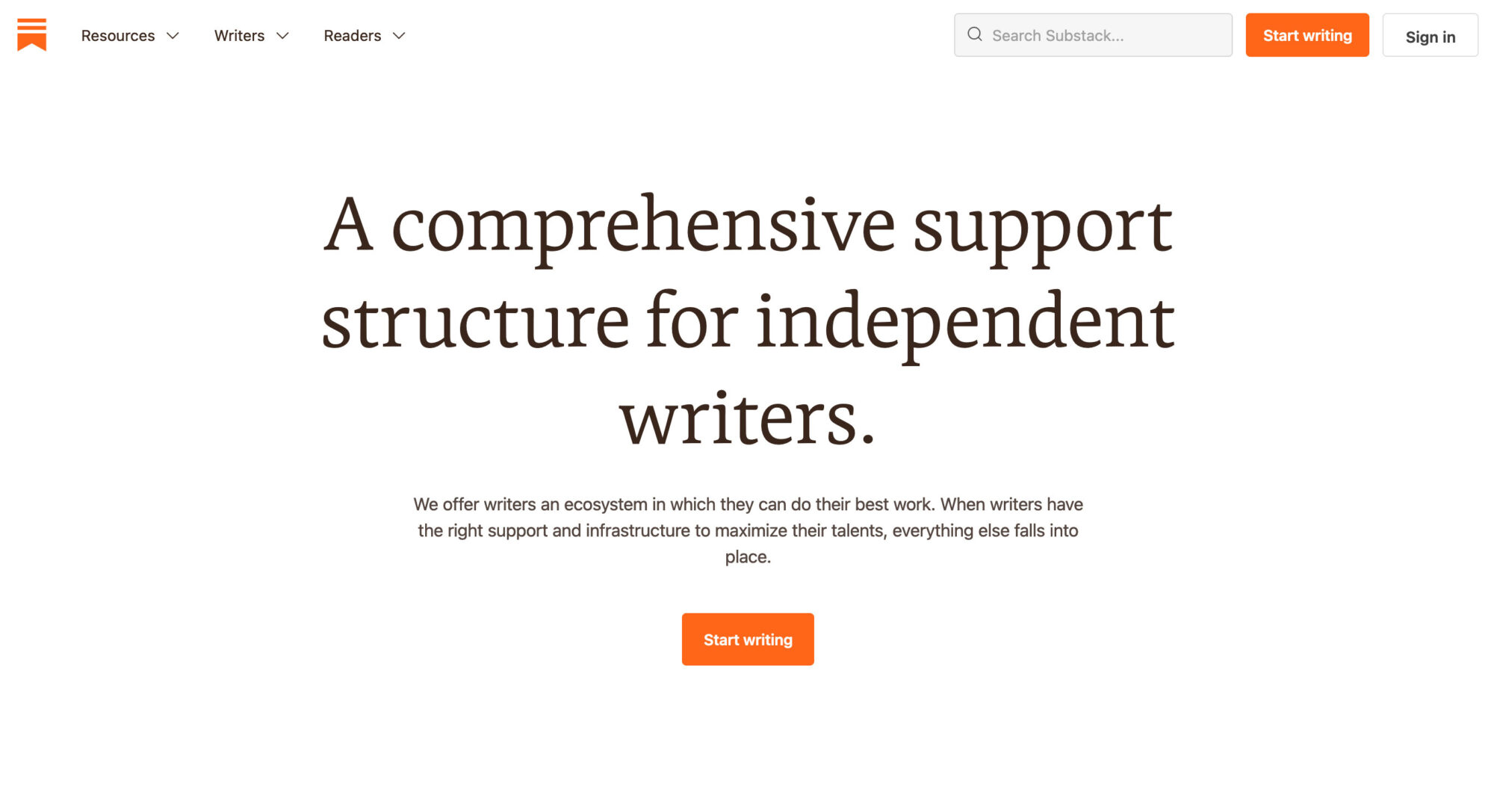
Develop a content strategy that aligns with your business goals and helps you to create content your target audience will love.
6. Use Engaging Headlines
Using engaging headlines is an important factor in attracting readers to your content. A headline is the first thing a reader sees, and can be a powerful tool for grabbing their attention and encouraging them to click through to your publication.
Here are some tips for creating engaging headlines:
- Make it engaging and informative: Your headline should be enticing enough to make the reader want to click through to your content, and should give an accurate summary of what they can expect to read or learn. Consider using strong action verbs or making a bold (but truthful) statement to grab the reader’s attention.
- Keep it short: Headlines should be concise and to the point. Aim for around 60 characters or fewer, so the entire headline is visible in search results.
- Use keywords: Including relevant keywords in your headline can help to improve your SEO and make your content more visible to potential readers. The right keywords should come naturally if your headline is accurately representing the article’s content.
- Use numbers: Lists and numbered articles tend to perform well because they give readers a clear idea of what to expect and make it easy for them to understand the content.
Create engaging headlines that grab readers’ attention and encourage them to click through to your content.
7. Use Visuals
Visuals help to engage readers and make your content more appealing. Images, videos and infographics can help to break up text and make your content easier to digest, which can help to keep readers engaged.
Here are some tips for using visuals in your publication:
- Use high-quality images: Make sure pictures are relevant to your content, add value for your readers and are of good quality. Avoid using low-quality or unrelated images, as they can distract from your content.
- Choose visuals that support your message: Don’t use visuals for the sake of it — they should add value and have a purpose that supports the narrative.
- Add alt tags for images: Alt tags are descriptions of images that are used by screen readers for people with visual impairments. By including alt tags, you can ensure your content is accessible.
- Use videos: Videos can be a powerful tool for engaging readers and making your content more interactive. Consider including videos in your content where relevant/possible to add variety and further engage your visitors.
- Consider infographics: If you have complex information to convey, then infographics can be a great way to present it in a visually appealing way. Consider using them to help readers to understand difficult topics or to illustrate data or statistics in a way that’s more engaging and easier to digest.
8. Optimize for Search
SEO (search engine optimization) is the practice of optimizing your website and content to make it more visible and attractive to search engines. Improving your content’s ranking in search engine results pages will make it discoverable to new readers, and so help to grow your audience.
Here are some tips for optimizing your publication for SEO:
- Use relevant keywords: Including relevant keywords in your content can help to improve your ranking in search engine results pages. Research keywords that are relevant to your content and incorporate them naturally into your text.
- Use header tags: Header tags (H1, H2, etc.) help search engines to understand the hierarchy and structure of your content. Use header tags to break up your content and make it more user-friendly.
- Use alt tags for images: As mentioned earlier, these are descriptions of images used by screen readers for people with visual impairments. By including alt tags for your images, you can improve the accessibility of your content and help it to rank better in search results.
- Use descriptive titles and URLs: These will help search engines to understand what your content is about, so avoid using vague or generic titles and URLs.
- Use internal linking: Linking to other pages on your website from within your content helps search engines to understand the structure of your website and can improve the ranking of your pages.
9. Engage with Your Readers
Building a relationship with your readers is important for growing a loyal following and increasing the success of your publication, so make an effort to engage with them through comments, social media or email newsletters.
Here are some ways you can engage with your readers:
- Respond to comments: Encourage your readers to leave comments on your content and make an effort to respond to as many as possible. This helps to build a sense of community and shows your readers you value their feedback.
- Use social media: Social media platforms, such as Twitter and Instagram, are great ways to engage with your readers. Share links to your content and respond to comments and messages to build a relationship with your followers.
- Use email newsletters: Consider sending email newsletters to your subscribers to keep them up to date on new content and promotions. You can also include a section for reader feedback or questions to encourage engagement.
- Create a community: Consider creating a private community, such as a Facebook group or Slack channel, for your readers to engage with each other and with you. This can help to build a sense of community and encourage readers to become more invested in your publication.
10. Collaborate with Other Substack Writers
Collaborating with other writers can help you to build your audience and create new content, and there are several ways you can engage with other creators on Substack:
- Join Substack communities: Substack has a number of communities for writers that you can get involved with and connect with other creators.
- Participate in writing challenges: These are events where you’re given a prompt or topic to write about, and are a great way to build relationships within the community.
- Join forces: Consider reaching out to other writers on Substack who align with your niche, values and target audience to work together on a project. This could be a joint blog post, podcast or video series that could help both of you to reach new readers.
- Share and promote each other’s work: Engage with and promote other writers’ work on Substack. Share their content on social media, leave comments on their posts and consider featuring them on your own publication.
11. Build an Email List
Collecting email addresses from people who are interested in getting updates from your publication is an important way to market to your following and build relationships, allowing you to reach this section of your audience with targeted content.
Here are some ways you can build your email list:
- Offer an email newsletter: Consider offering an email newsletter to your readers in exchange for their email address. You can use the newsletter to keep them up to date on new content and promotions.
- Use opt-in forms: Place opt-in forms on your website or social media pages to collect email addresses from interested readers.
- Offer incentives: Consider offering incentives, such as exclusive content or discounts, to encourage readers to sign up for your email list.
- Engage with your readers: Talking to your readers and responding to their comments and questions can help to build a loyal following and encourage them to sign up for more updates.
Top Tip: Here’s how one writer, Scott Hines, got his first thousand subscribers!
12. Monetize Your Publication
Monetizing your Substack publication is an important step in building a successful business, and there are several ways you can do this (plus Substack has an excellent guide on the matter):
- Offer paid subscriptions: This could be a good option if you have a loyal following and are creating high-quality content that’s worth paying for.
- Run ads: There are several options for running ads on Substack, such as sponsored posts or display ads.
- Sell merchandise: Selling T-shirts, mugs or bespoke items that are relevant to your niche and audience can be a good option if you have a strong brand and a loyal following.
- Offer services: If you have expertise in a particular area, consider offering services, such as consulting or coaching, to your audience.
It’s important to experiment with different monetization strategies to find what works best for your publication. Try testing different options and collecting data to see which strategies are most effective for generating revenue.
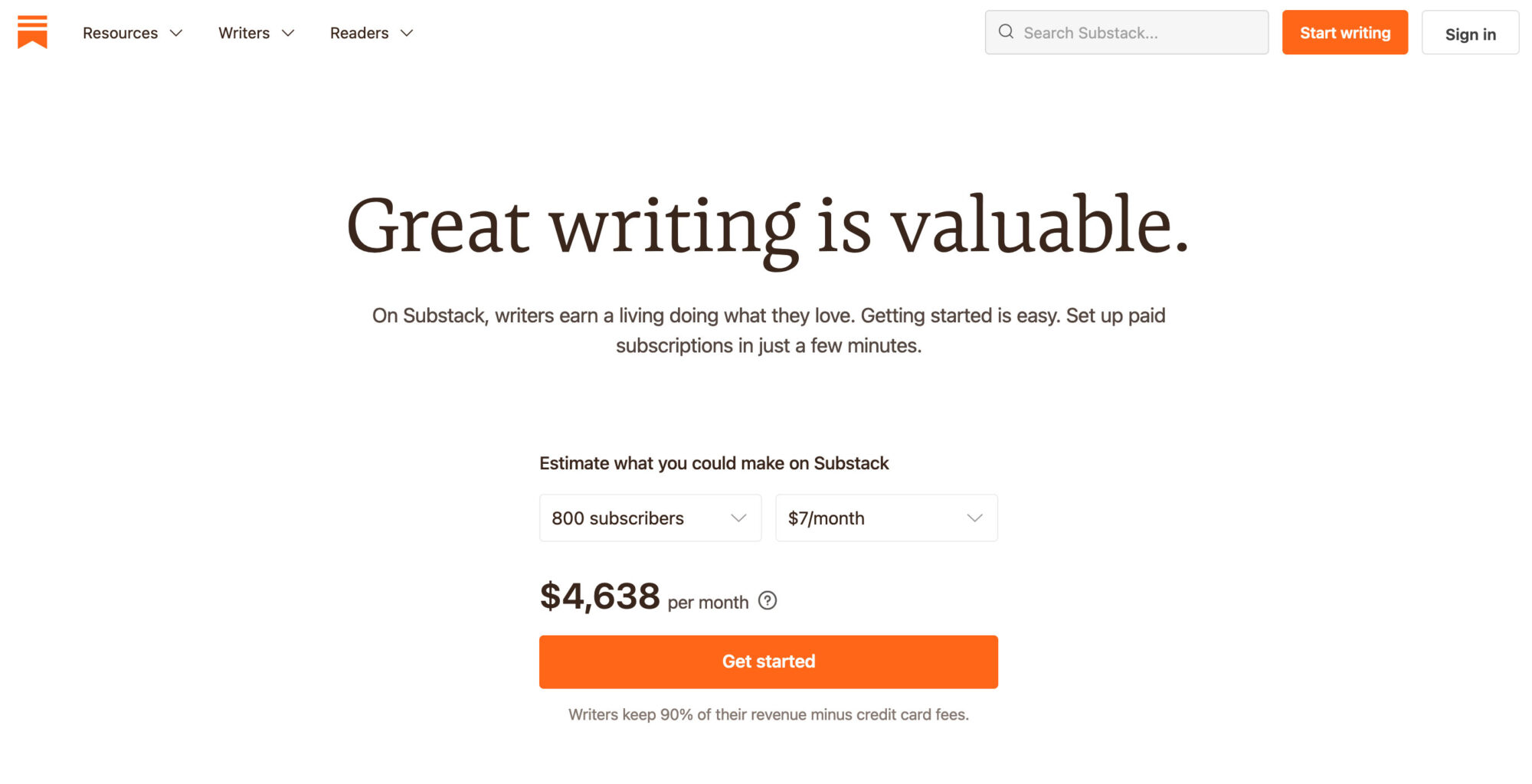
Overall, monetizing your Substack publication is an important step in building a sustainable and successful business.
Top Tip: Here’s an interesting read on someone who left his full time job going paid on Substack.
Should I Monetize My Substack?
Whether or not to try to make money from your Substack publication is a personal decision that depends on your goals and resources. Here are some of the pros of monetizing your publication:
- It can provide a source of income: Monetizing your publication can provide a source of income to support your business and help you to achieve your financial goals.
- It can help you to build a more sustainable business: Monetizing your publication can help you to build a more sustainable business by generating revenue to support your efforts.
- It can help you to create better content: Monetizing your publication can give you the resources to invest in creating high-quality content and improving your publication.
On the other hand, here are some of the reasons why you may not want to monetize your publication:
- You want to focus on creating content: If you’re not focused on monetizing your publication, you can put your energy into creating content that resonates with your readers and building a loyal following.
- You can serve a broader audience: If you’re not concerned about making an income, you may be able to reach a wider audience by offering your content for free.
Ultimately, the decision to monetize your Substack publication or not depends on your goals and resources, so consider your priorities and what’s most important to you before making a choice.
And sometimes free blog posts pay!
13. Experiment with Different Formats
Experimenting with different formats (here’s a quick YouTube video of some the options and ideas suggested by Substack) is an important step in finding what works best for your publication and your audience. There are many different formats you can use, including the following:
- Long-form articles: These are in-depth pieces of content that typically range from 1,500 to 5,000 words. These can be a good option if you have a lot of information to share or want to cover a complex topic in detail.
- Newsletters: Use these to keep your readers up to date on new content and promotions. You can send them regularly or on an as-needed basis.
- Podcasts: Consider creating a podcast if you want to have an interview or discussion-type format, or if you want to give your audience the option to consume your content on the go.
- Video content: Video can be a powerful way to engage your audience and make your content more interactive. Consider creating video content, such as interviews or tutorials, to add variety to your publication.
Don’t be afraid to try a few of these formats to see what works best for your publication and your audience.
14. Stay Consistent
If you want to create a publication your readers return to, they’ll need to have an idea of what to expect from your content. Having a regular publishing schedule and maintaining a consistent tone and style will help you to create a strong brand and build a loyal following.
Here are some tips for staying consistent with your publication:
- Publish new content regularly: It’s important to publish new content on a consistent schedule to keep your readers engaged. Determine how often you want to publish new content and stick to a schedule.
- Define a tone: Your tone should be clearly defined and consistent, and should resonate with your audience demographic. This will help to create a strong brand and make your content recognizable to your readers.
- Develop a style: Having recognisable style elements, including fonts, layouts, colors and/or a logo, can help to create a cohesive look that your readers will recognize.
- Keep your branding consistent: Your branding, including your logo and color scheme, should be consistent across all of your content and marketing materials.
15. Focus on Quality Writing
There are several ways you can ensure your writing on Substack is interesting, engaging and high quality:
- Use strong, active verbs: These can make your writing more engaging and interesting, while writing in a passive voice can come across as less compelling.
- Use descriptive language: Your readers should be able to visualize and engage with your content, so avoid using generic or vague language that may confuse your message.
- Edit and revise your writing: Make sure to take the time to edit and revise your writing. This will help you to catch any errors or typos and keep your publication professional.
Ensure your writing is interesting, engaging and high quality, and create content that resonates with your readers!
Bonus: Promote Your Publication!
Getting the word out there about your new Substack publication is vital if you want to attract readers, and there are several ways you can promote your content online:
- Use social media: Social media platforms, such as Facebook, Twitter and Instagram, are a great way to market your publication, share links to your content and engage with your followers.
- Collaborate with other influencers: Working with other folk who already have a following in your niche can help to spread the word about your publication and attract new readers. Consider reaching out to other websites or influencers in your field to see if they’d be interested in collaborating or promoting your publication.
- Use paid advertising: Consider using paid advertising platforms, such as Google AdWords or Facebook Ads, to promote your publication to a targeted audience.
Final Thought
We hope these tips have given you the information and inspiration you need to get started on your publishing journey.
Starting a new publication can be a daunting task, but with hard work, dedication, and a little bit of luck, you CAN create a successful publication on Substack.
We wish you the best of luck with your new publication.
Happy publishing!
Oh, and for another other questions, check out the official Substack Help and FAQs — and/or leave a comment below!

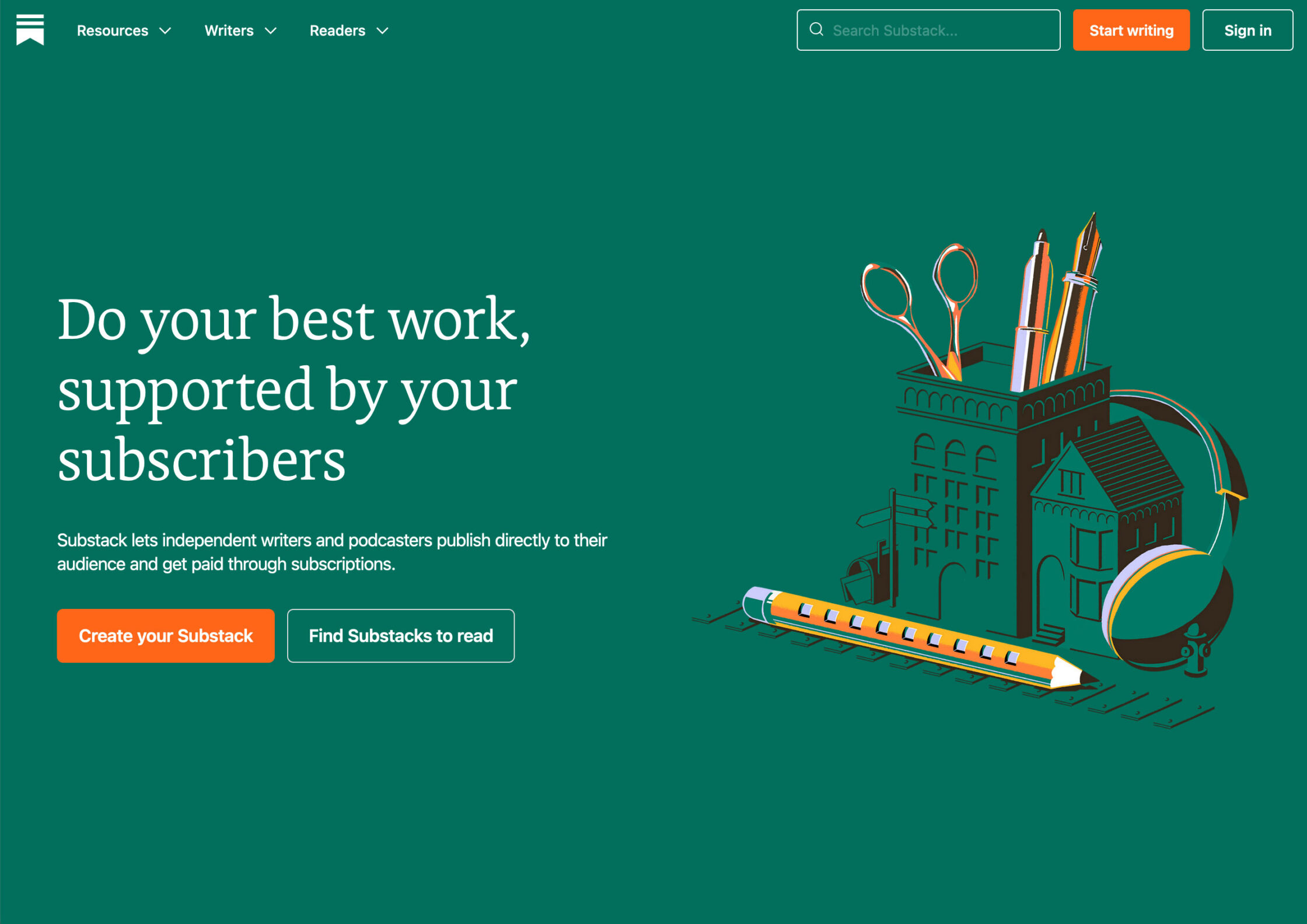
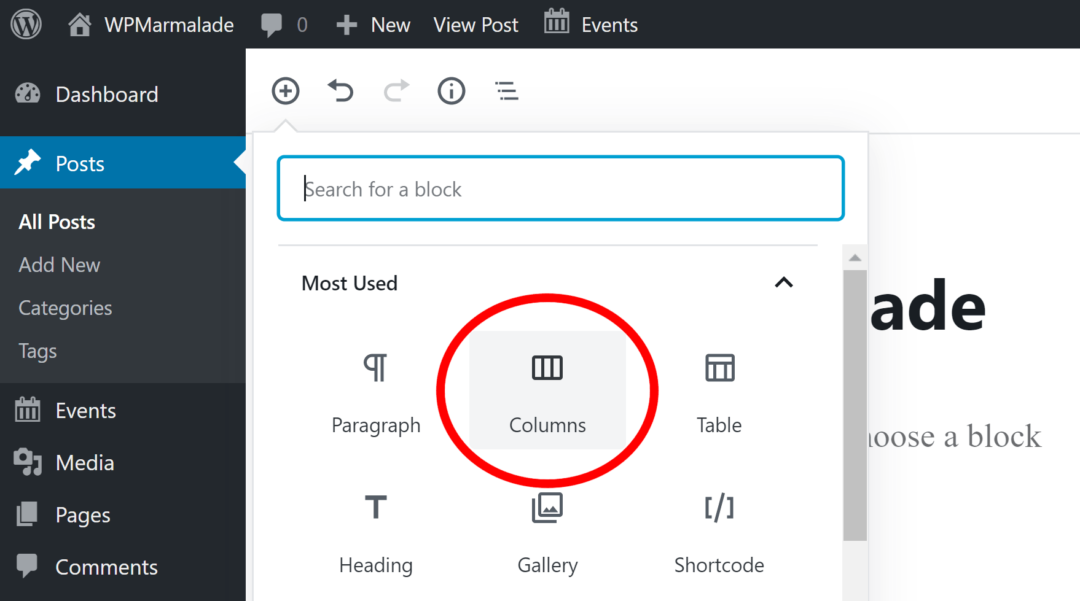
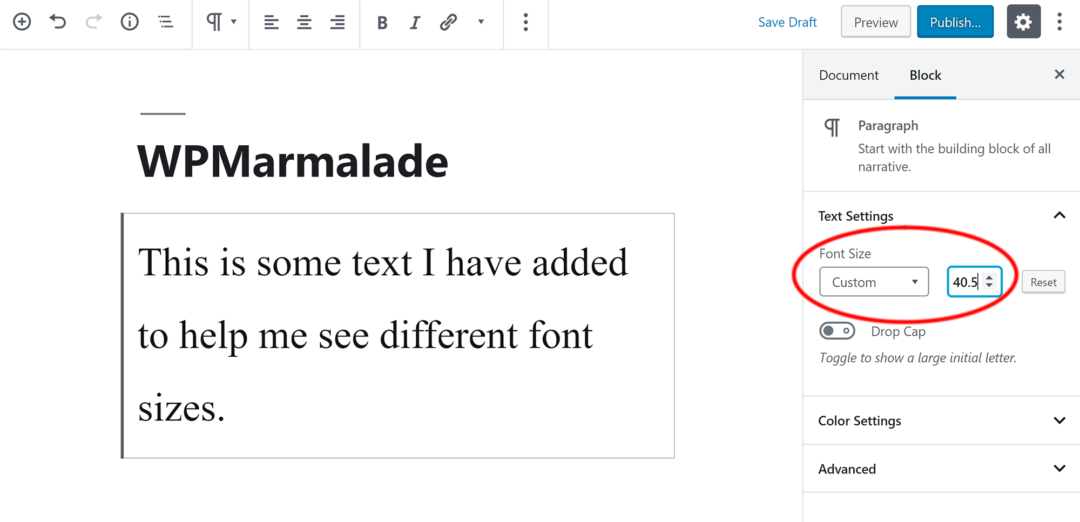
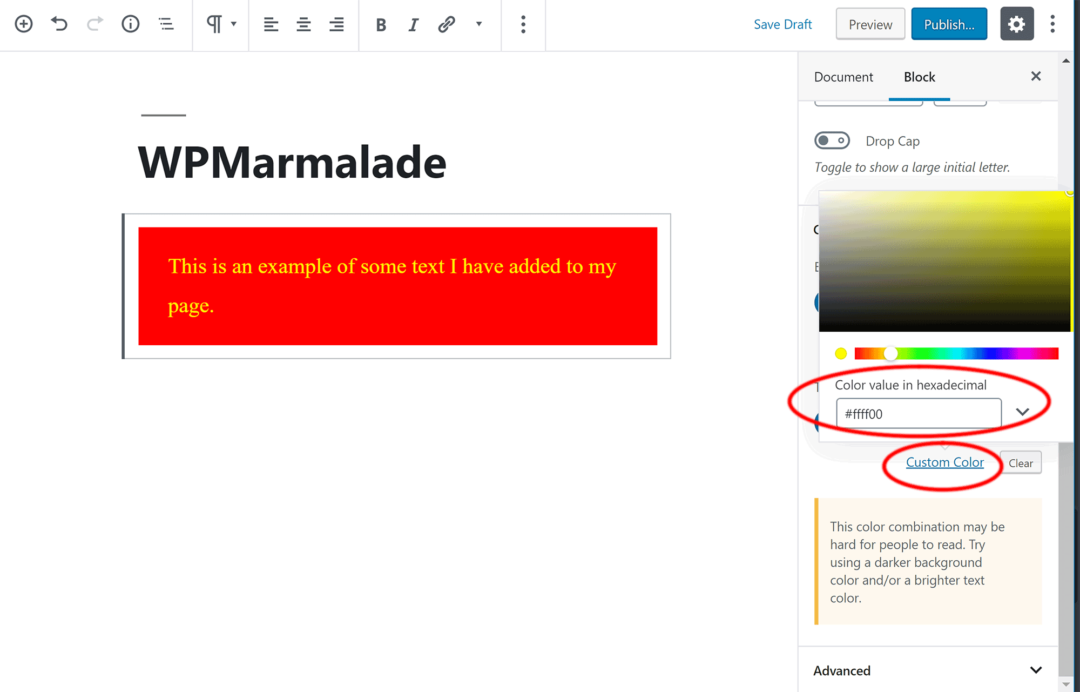
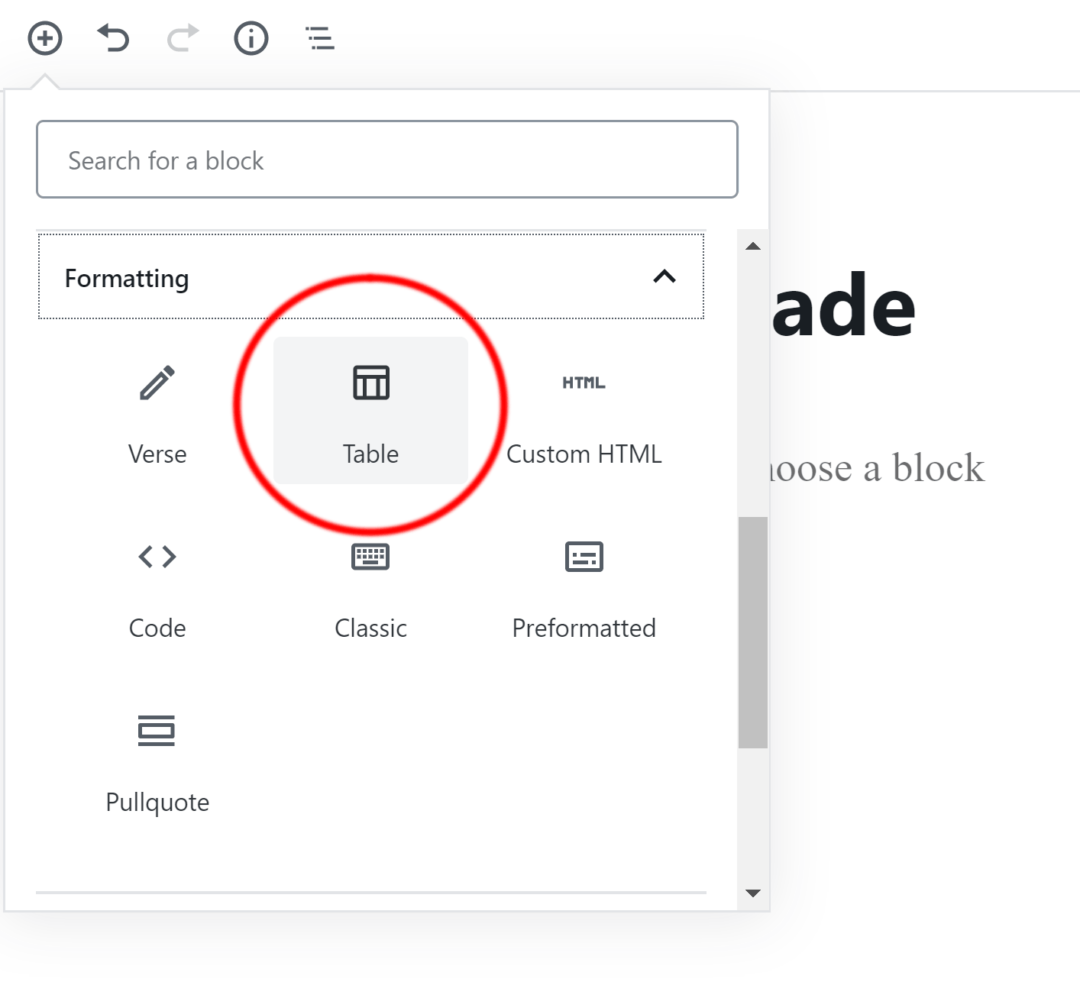
1 Comment
I have been posting a daily email to an ever-growing list of friends for ten years, accessible by invitation only. I use Mailchimp and am looking to move to Substack, I think. I’m looking for advice and maybe a tech collaborator, since I’m a tech cripple and short on time. Interested in an initial discussion or suggestions of whom I might talk to. Have published two books, a third out with my agent now. Thanks for your thoughts.